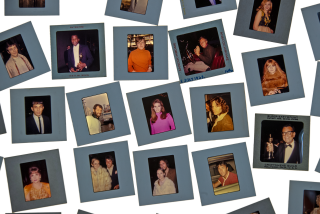Schizophrenia in a candid close-up
- Share via
As a senior fine arts major at Pittsburgh’s Carnegie Mellon University, 21-year-old John Cadigan withdrew into the shadows of his basement apartment, so afraid to leave that he stopped attending classes. At times he was unable even to move. A series of mental health labels was pinned on him until he was finally diagnosed with refractory schizophrenia. He had to drop out of college and move to California, where his sister Katie, a filmmaker, began helping him to record what his life was becoming. The result is the compelling documentary “People Say I’m Crazy,” a candid self-portrait that chronicles John’s decade-long struggle to live with and understand his illness.
Rather than making broad generalizations about schizophrenia, the Cadigans, who co-directed, have created what is essentially a video journal, narrated in matter-of-fact tones by John himself. From the “morning dread” he faces at the boardinghouse he shares with other mentally ill adults, to meetings with his doctor and visits to his mother, who moved from Boston to be near him, we follow him through his day. Cadigan’s artwork flourishes -- his distinctive woodcut prints have been shown at galleries and museums around the country -- but even the simple goal of independent living can appear to be perched on an unreachable mountaintop.
We first meet John in extreme close-up as he recounts the terrifying onset of his illness. His social withdrawal seems to have occurred gradually. When he was in fifth grade, Cadigan tells us, he was voted most popular, most athletic and most artistic in his class. By the time he was a senior in high school, he was voted the quietest.
In 1994, after all available drugs as well as electroconvulsive therapy had failed to help him, a new doctor and a new drug made him more functional but resulted in a 100-pound weight gain.
The physical transformation is astounding. The trim, clean-cut collegian becomes a bear-like man with a full beard and long dark hair pulled back into a ponytail. The premature gray at his temples betrays the gantlet of tests and medications he’s had to run.
Undeniably, John is able to function as well as he does because of his family’s support. Still, some of the more interesting parts of the film are off-the-cuff interviews and verite moments that speak to the tricky dynamics of the situation. The family walks on eggshells to avoid saying something that John, in his paranoia, might misinterpret, but relatives also subtly hint at unaddressed friction in their own relationships.
In a sequence in which John’s sisters Katie and Anne prep him to speak at an exhibition in Washington, D.C., John is painfully aware that his paranoia makes it difficult for him to distinguish when he is being helped and when he is being manipulated. Their father, an Episcopal minister who is divorced from their mother, tries to add his own pointers but is quickly dismissed.
While it may be impossible to fully convey the isolating qualities of the disease, Cadigan describes nearly unbearable days when his mind becomes “jumbled,” making it impossible to read or even string together sentences.
The film lacks the scope and distance that could have been provided by an outsider, someone who might have delved more deeply into the family’s relationships, for example. But “People Say I’m Crazy” speaks in such a clear and frank way, avoiding self-indulgence, that its limits are forgiven. One scene in particular, in which Cadigan breaks down as he reveals the dark imagery that plagues him and that becomes the raw material for his mythic-looking woodcuts, stays with you.
*
‘People Say I’m Crazy’
Where: Cinemax
When: 7 tonight
Directors John Cadigan with Katie Cadigan. Producers Katie Cadigan and Ira Wohl. Editor Laura C. Murray. Cinematographers John Cadigan, Laura C. Murray, Katie Cadigan. Music Evelyn Glennie.











